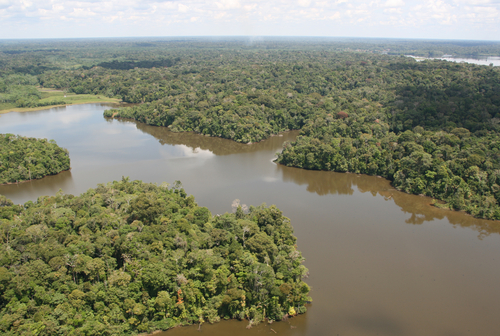Agriculture intensification could spare large tracts of tropical forest

Amazon River in Peru
Published today, a special issue of the Philosophical Transactions of The Royal Society – Biological Sciences, addresses a major challenge facing our society: feeding a global population that is simultaneously growing and increasing its per capita food consumption, while preventing widespread ecological and social impoverishment.
According to Michael T. Coe, Senior Scientist at The Woods Hole Research Center (WHRC) and one of the issue’s co-editors, “One important finding presented in these papers is that landowners respond quickly to external and internal forces, particularly signals from government and market forces to be better land stewards.”
The special issue contains 18 articles from researchers in Brazil, the United States, and Europe. The articles focus on the agricultural transformation of the southeastern Amazon and address three primary topics:
Trends in land-use change in Mato Grosso, Brazil (MT);
Ecological and social consequences of land use change;
Landscape management strategies that can reduce environmental degradation in agricultural frontiers.
Primary conclusions of the papers include:
Trends in land-use change in Mato Grosso, Brazil (MT)Analysis shows that MT’s development from 1990 to 2005 was largely based on economic activities that resulted in deforestation, forest degradation, and associated socio-ecological consequences. During this period, approximately 70,000 km2 of forests were converted to low-productivity pasturelands, which degraded streams, increased disturbance (for example, via escaped forest fires), and altered the regional climate. Policies enacted as early as 2004 began reversing those trends. The national standard for Brazil was to set policies to reduce Amazon deforestation by 80 per cent by 2020; MT formulated its own goals, achieving remarkable results by the late 2000s.Emphasizing this, lead-editor Paulo Brando, Scientist at the Amazon Environmental Research Institute (IPAM) and Visiting Fellow at WHRC, said “The widespread reduction in Amazon deforestation is a great achievement, but forest fires, logging, pesticides, etc. still threaten the integrity of tropical ecosystems. Best agricultural management practices could minimize their impacts, being a key instrument to secure the health of forests and streams in the Amazon and in other tropical regions.”
Ecological and social consequences of land use changeEcological and social problems related to land management remain, including degradation of forests by the combination of human-induced fires and drought; impoverishment of aquatic ecosystems through the widespread application of agricultural chemicals and lack of stream restoration; and loss of indigenous peoples’ livelihood options because of ecological degradation. Furthermore, forest conversion is expected to increase with increasing national and international demand for soya, beef and/or palm oil.
Landscape management strategies that can reduce environmental degradation in agricultural frontiersA major challenge for sustainable management of tropical agricultural landscapes is highlighted: to transform low-yield, high-deforestation production systems into high-yield, low-deforestation ones. Extensive tracts of land in Brazil’s cattle ranching frontier, could undergo these transformations where approximately 200 million hectares of pasture sustain notoriously low cattle densities. Recent declines in MT’s deforestation, coupled with increases in crop and cattle productivity, suggest that agriculture intensification could spare large tracts of land for tropical forest conservation.
Co-editor Ruth DeFries of Columbia University notes that “The experience in Brazil’s southern Amazon illustrates that deforestation can be controlled simultaneously with increases in agricultural production, but policies and incentives to reach these objectives are not yet in place in many other tropical forest regions.”
Source: AAAS EurekAlert
Photo: Amazon River from Shutterstock
[source: http://feeds.importantmedia.org/~r/IM-greenbuildingelements/~3/kTdNYs8TFcI/]

Leave a Reply
You must be logged in to post a comment.